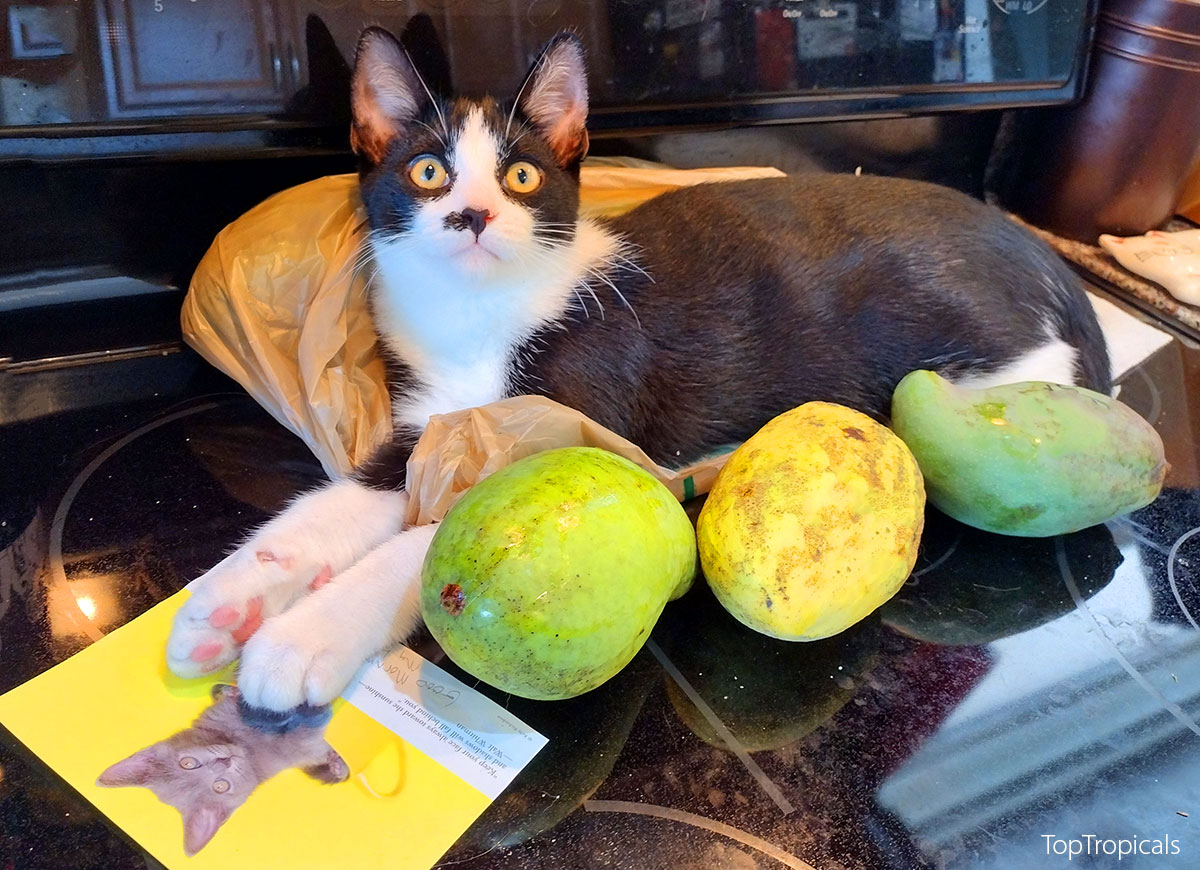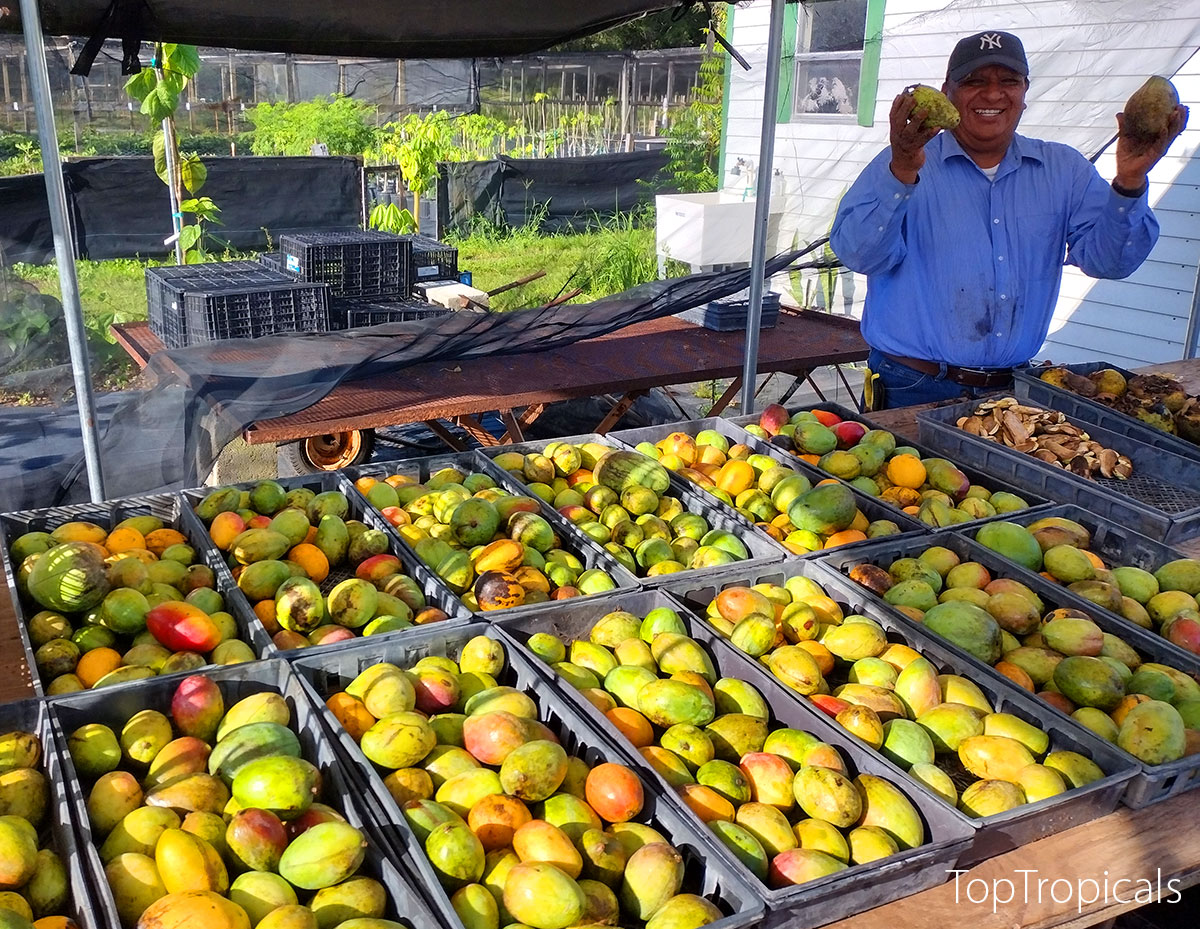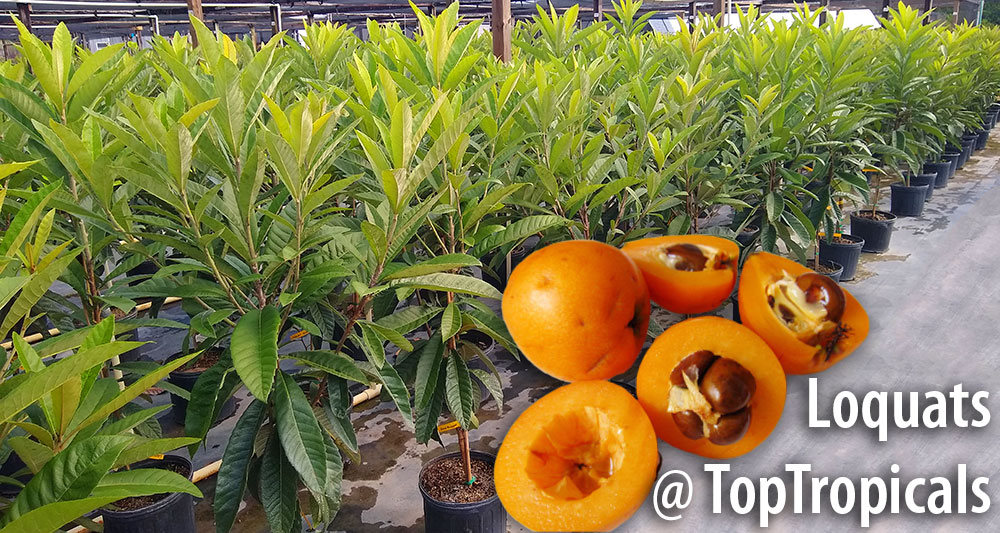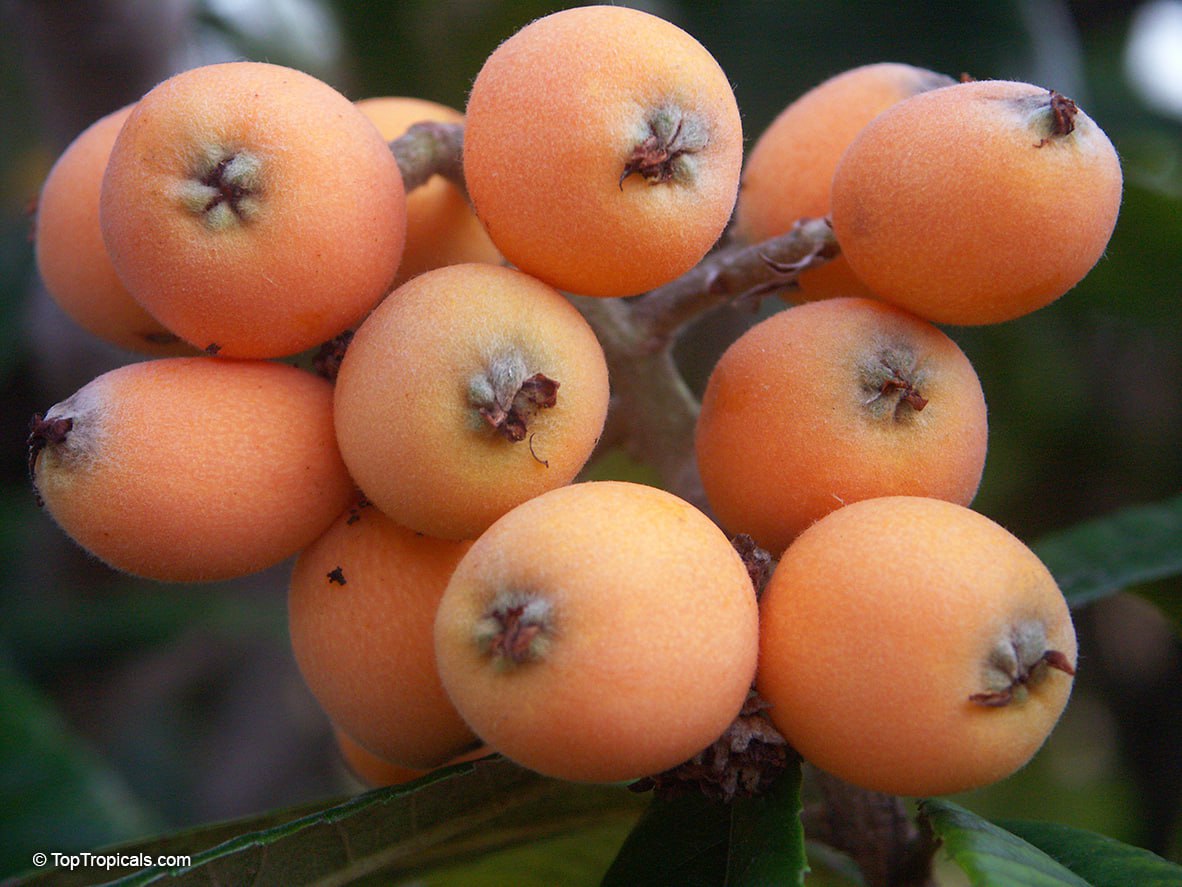Garden Blog - Top Tropicals
Date:
Top 5 favorite Mango varieties
and Top 10 Condo Mango trees
How to chose the right variety of a Mango tree?
Q: The most Frequently Asked Question about fruit trees: What is your favorite Mango variety? Which mango varieties are the best? Help me to make a choice!
A: As we mentioned on our Introduction to Mango Varieties page, there are thousands of named mango cultivars available. Similar to the classification of avocados (see our Avocado Variety Guide), mango trees can be selected based on your specific needs. These needs can include tree size and growth habit, disease resistance and hardiness, and most importantly, fruit characteristics such as taste, texture, size, color, storage ability, juice and sugar content.
We are currently working on a comprehensive Mango Variety Guide and will be sharing it
with you soon. In the meantime, below are a few tips on selecting the right mango tree.
NOTE: all of the Mango varieties we offer are FIBERLESS!
Top 5 Favorite Mango we just love!
1. Alphonso - the best Indian cultivar in terms of sweetness and
flavor. One of the rarest varieties and sought after - sweet large juice fruit. Coconut-like flavor.
2. Maha Chinook - Many
consider it the best mango had ever tasted. Very rare mango variety from Singapore. This variety is semi-dwarf and great for pot culture. Nam Doc Mai close relative.
3.
Fralan - Super reliable producer and hardy tree. Green fruit, sweet and
juicy. Fralan means "Thunder" - as the fruit cracks when peeled.
4. Fruit Cocktail -
Flavor is an amazing palette of different fruit, with citrus, pineapple, and guava notes.
5. Nam Doc Mai - It's not just us, everyone loves this Mango!
The most popular variety: semi-dwarf and great for pot culture. Eaten green or ripe, a Thailand favorite. It is hands down the most sought after of the Asian mangoes and for good
reason.
Top 10 Dwarf "Condo" Mango
1.
Mallika - condo mango native to India. Among the best of the new generation of Indian dessert mangos. Intensely sweet, rich and highly aromatic flavor with hints of citrus and melon.
2. Ice Cream - far and away the most popular of the "condo mangoes." Flavored like the name. The tree can easily be maintained at a height of just six feet (!) making it ideal for container growing.
3. Julie - the most popular variety in Jamaica and many other Caribbean islands because of
its rich, sweet, coconut/pineapple-like flavor. It is a dwarf cultivar, great for containers, but keep in mind it's very cold sensitive, don't plant it in the ground if you get freeze in winter.
4. Okrung - Thai compact cultivar,
fruit eaten while green. The fruit is traditionally served in Thailand in combination with sticky rice. One of the most popular varieties in Thailand. The fruit is very sweet, with the highest sugar content.
5. Pickering - great for pot culture. It has a bushy, compact growth habit, and can be maintained in a container at just six feet (!). The fruit has a firm
flesh with a fantastic coconut/mango flavor.
6. Nam Doc Mai - The most popular variety for pot culture, we already mentioned in our favorites above.
7. Cogshall - an ultra compact grower. Suitable for container growing on a balcony, or planting in a suburban backyard. It can easily be maintained at just eight feet tall, and it will still produce a good size crop year after year. The fruit is very colorful and has a mild, sweet flavor. It is also fungus resistant.
8. Carrie - the flavor
is by far the most outstanding. It has absolutely no fiber and extremely rich in flavor, sweet, aromatic and a pure pleasure to eat. You will savor every mouthful! Its compact size makes it an excellent dooryard tree.
9. Diamond - It has a great taste very similar to Nam Doc Mai. Very compact, of a dwarf habit, great as condo mango.
10. Keitt - the best all-around late mango. It is very productive, good-flavored, and disease resistant. It also has a very long and late season. The compact tree is semi dwarf that bears 4-5 pound goliath fruit!
Photo above: Pim Seng Mun mango tree is a reliable and heavy producer.
Top 5 recommended vigorous growers and reliable producers
1. Glenn - Excellent eating quality, consistent production, and effortless to grow.
2. Pim Seng Mun - extremely productive mango.
3. Sweet Tart - New patented variety - exclusive offer.
4. Fruit Punch - Multi fruit flavor, delicious!
5. Orange
Sherbet - One of the best new varieties for backyard growing. Flavor is sweet citrus-orange and less lemony than Lemon Meringue mango. The tree is moderately vigorous.
Top 5 exotic varieties for rare fruit collection
Now that you have decided to collect them all but have limited space, these are the top 5 of the most interesting rare cultivars:
1. Kar Lon Long -
rare and unusual, native to India. Fruits that can weigh up to 5 lbs each! The unique flavor that has been described as being a cross between a mango and a pineapple.
2. Mun Kun Si - similar to Nam Doc Mai but much bigger. Rare variety, very popular
among Thai and Vietnamese people. The fruit are extremely sweet, fiberless and somewhat crunchy ("Mun" means crunchy). Very late producer, fruit may still be on a tree as late as January.
3. Pina Colada - very sweet, has rich flavor with a hint of coconut and pineapple.
4. Ugly Betty - awesome mango, great sweet flavor, while the fruit is real ugly! Slightly mis-shaped at the top - hence the name.
5. Giselle - from Zill's breeding program and was a seedling of a mango called Tower. It was described as a juice mango and is named after Gary's wife.
Photo above: preparing mango seeds for planting - growing seedlings for future grafting.
When you are in the mood for something special - you need a Loquat Liquor
🍑 Loquat tree is an excellent choice for any garden, as it is quite cold hardy, drought-, poor soil- and salt tolerant. The delicious fruit look and taste similar to apricots, but there is only one problem: there are too many of them! Make Loquat the perfect fruit for an easy home winery...
🍹 Loquat Liquor recipe
Wash loquat fruit and slit in 4-5 places. You may leave seeds in for Apricot-nutty flavor similar to Amaretto. Combine fruit with vodka and sugar in a wide mouth jar and cover. Stir fruit once a day until sugar is dissolved. Then stir once a week for 4 weeks. Drain liquid and strain through fine cheesecloth. Enjoy!
You can dispose the used fruit but we usually give it a second life: add water, bring to boil, let sit, chill, and it will make another (almost non-alcoholic) drink!
✔️ 3 quarts of loquat fruit- ✔️ 1 quart vodka
- ✔️ 3 cups sugar
- ✔️ vanilla to taste (optional)
📚 From previous posts:
🎥 YouTube video about Loquat
📁 Overlooked fruit: tasty Loquat recipes (PDF)
🛒 Shop Loquat varieties
#Recipes #Food_Forest #Loquat
🔴 Join 👉 TopTropicals
From seed to fruit. How to grow Loquat from seeds, step-by-step guide. Part 2: after germination
Continued from previous posts⤴️
- 🍑 4. Transplanting Seedlings
- ▫️When to Transplant: Once seedlings reach about 2-4” (5-10 cm) in height.
- ▫️Transplanting and fertilizing: Move each seedling to its own pot and add controlled release fertilizer (Green Magic is the best), or use liquid balanced fertilizer Sunshine Boosters after 1-2 weeks once the seedlings establish.
- ▫️Watering. Keep soil in a pot slightly moist but not soggy
- ▫️Temperature. Keep seedling warm - above 70F (21C), and protect from extreme heat over 90F (35C) . For small plants, avoid freezing temperatures during winter. As the seedlings get bigger, they get higher drought-, heat- and cold tolerance. Established Loquat trees (2-3 years and older) may take light freezing temperatures.
- ▫️Planting in the ground. You can plant the seedling in the ground when it reaches 2-3 ft tall (50-100 cm) in frost-free areas. During chill winter nights, young seedlings can be cold protected until established.
- 🍑 5. Sunlight Requirements
- ▫️Light Exposure: Loquat established seedlings thrive in full sun but can tolerate partial shade. Start seedlings in bright shade and protect from afternoon hot sun to avoid leaf burn. Once seedlings are established and new growth appears (2-4 weeks), gradually move them to full sun.
- ▫️Why adequate sunlight (full sun) is important:
- promotes healthy growth
- helps to avoid fungus and insect problems
- is critical for future flowering and fruit production
🍑 6. Fruit production
- ▫️Loquat seedlings start producing seed within 3-4 years from seed, providing adequate sunlight, warm temperatures and regular irrigation.
- ▫️Grafted Loquats start producing right away or the next year
- ▫️Fruit will develop over the winter and ripen from March through May depending on location
🛒 Shop Loquat Trees and enjoy fresh fruit benefits
📚 Learn more:
- 🟡about #Loquat
- 🟡A young Loquat tree is fruiting
- 🟡Ten best fruit trees to grow in Florida and Southern landscapes. # 10: Loquat Tree
- 🟡Loquat – the Symbol of Prosperity
- 🟡Learn more about Loquats
- 🟡10 best fruit trees to grow in Florida and Southern landscapes
🎥 YouTube video about Loquat
📁 Overlooked fruit: tasty Loquat recipes (PDF)
#Food_Forest #Loquat
🔴 Join 👉 TopTropicals
Date:
Grow your own food:
How hardy is a Loquat tree?
Q: I am looking for a fruit tree for my backyard that is low maintenance, fast fruiting, and can take some cold (I live in Orlando FL and we do get occasional frost in winter). I like the taste of Loquat fruit, it reminds me of apricots. How cold hardy is this tree?
A: Loquat tree is a very good choice for Florida gardens. It can
take both cold and heat and produces lots of tasty fruit right away. Last
winter when we had a record freeze in our area with a couple of nights around
25F, the only trees that didn't get any damage at all were Loquats and
Macadamias, and those were still young, newly planted 4 ft trees.
To learn more about Loquat trees, check out this
">video and article: Golden Loquat - the symbol of Prosperity.
This is how a young Loquat tree is fruiting
A young Loquat tree fruiting
For the previous posts⤴️
📚 Loquat in previous posts:
- 🟡about #Loquat
- 🟡Ten best fruit trees to grow in Florida and Southern landscapes. # 10: Loquat Tree
- 🟡Loquat – the Symbol of Prosperity
- 🟡Learn more about Loquats
- 🟡10 best fruit trees to grow in Florida and Southern landscapes
🎥 YouTube video about Loquat
📁 Overlooked fruit: tasty Loquat recipes (PDF)
🛍 Shop Loquat Trees and enjoy fresh fruit benefits
#Food_Forest #Loquat
🔴 Join 👉 TopTropicals
Date:
Golden Loquat - the symbol of Prosperity
by Alex Butova, the Witch of Herbs and Cats
...The Loquat is a wonderful tree, ideally suited to small gardens
thanks to its compact growth habit. The plant is very fast growing, drought
tolarant, and cold-tolerant to mild frost. It is an ideal fruit tree for the
beginner...
...The flavor is a mixture of peach, citrus and a mild mango...
...In China, the Loquat because of its golden color, represents gold and wealth. It is often one in a bowl or composite of fruits and
vegetables to represent auspicious wishes or the "Five Prosperities" or
wurui...
CONTINUE READING >>
Chinese believe that planting a Golden Loquat Tree will bring you prosperity and wealth. Growing a Loquat is like growing your own Money tree!
What tropical fruit tree is cold hardy and easy to grow? Its Golden Loquat the Symbol of Prosperity, and it tastes like
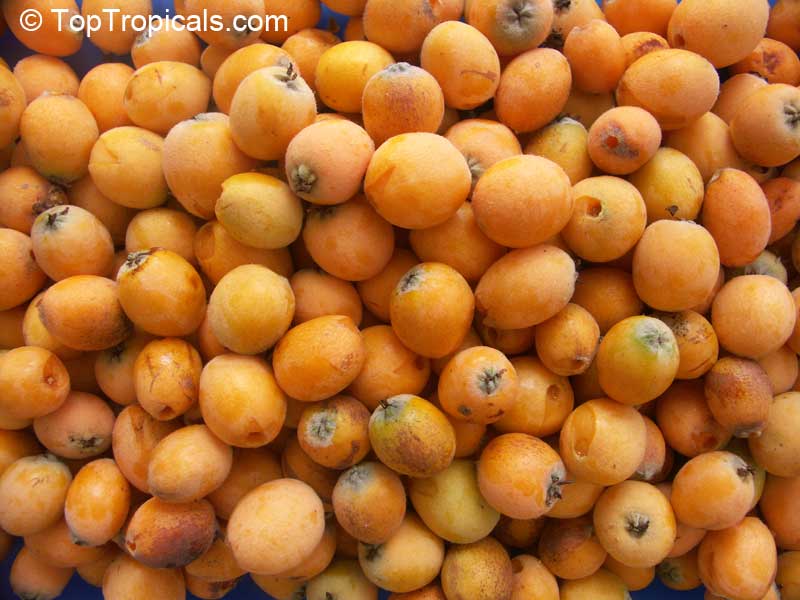
Loquat (Eriobotrya japonica) fruit

Loquat (Eriobotrya japonica) trees in pots
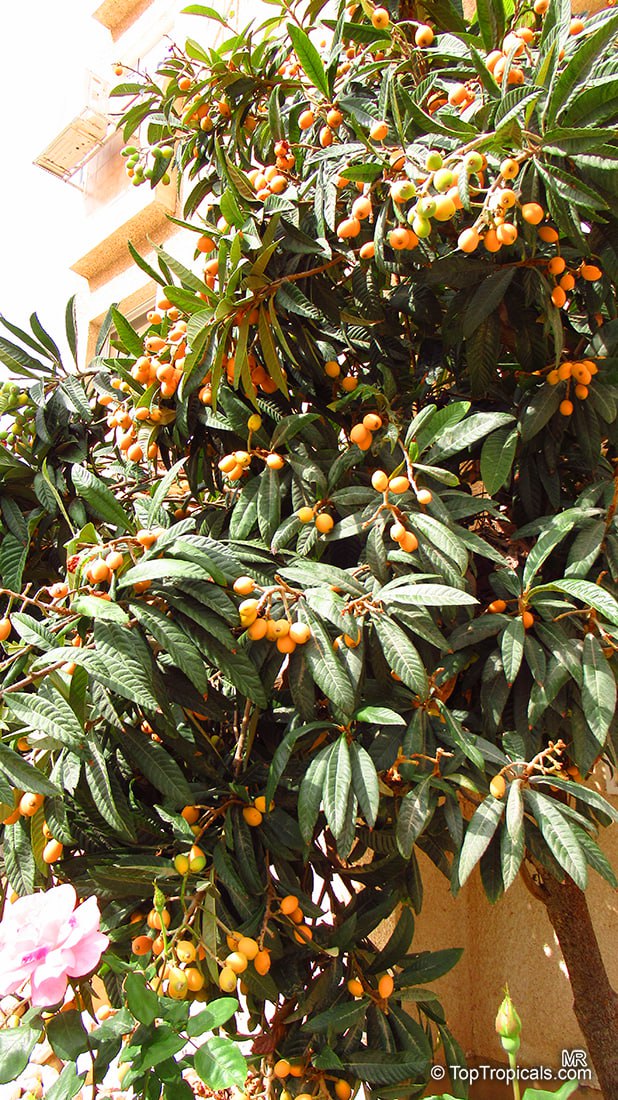
Loquat (Eriobotrya japonica) tree
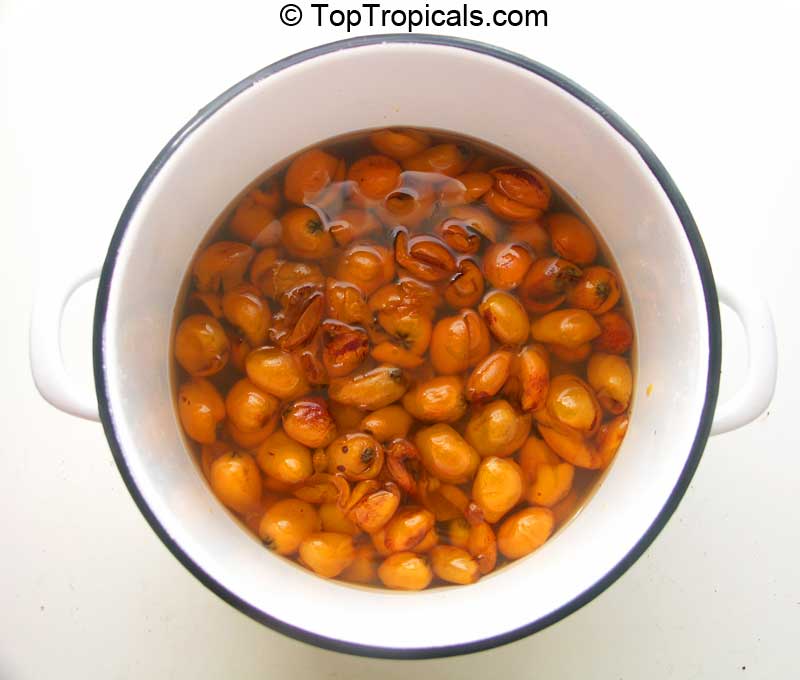
Loquat (Eriobotrya japonica) compot
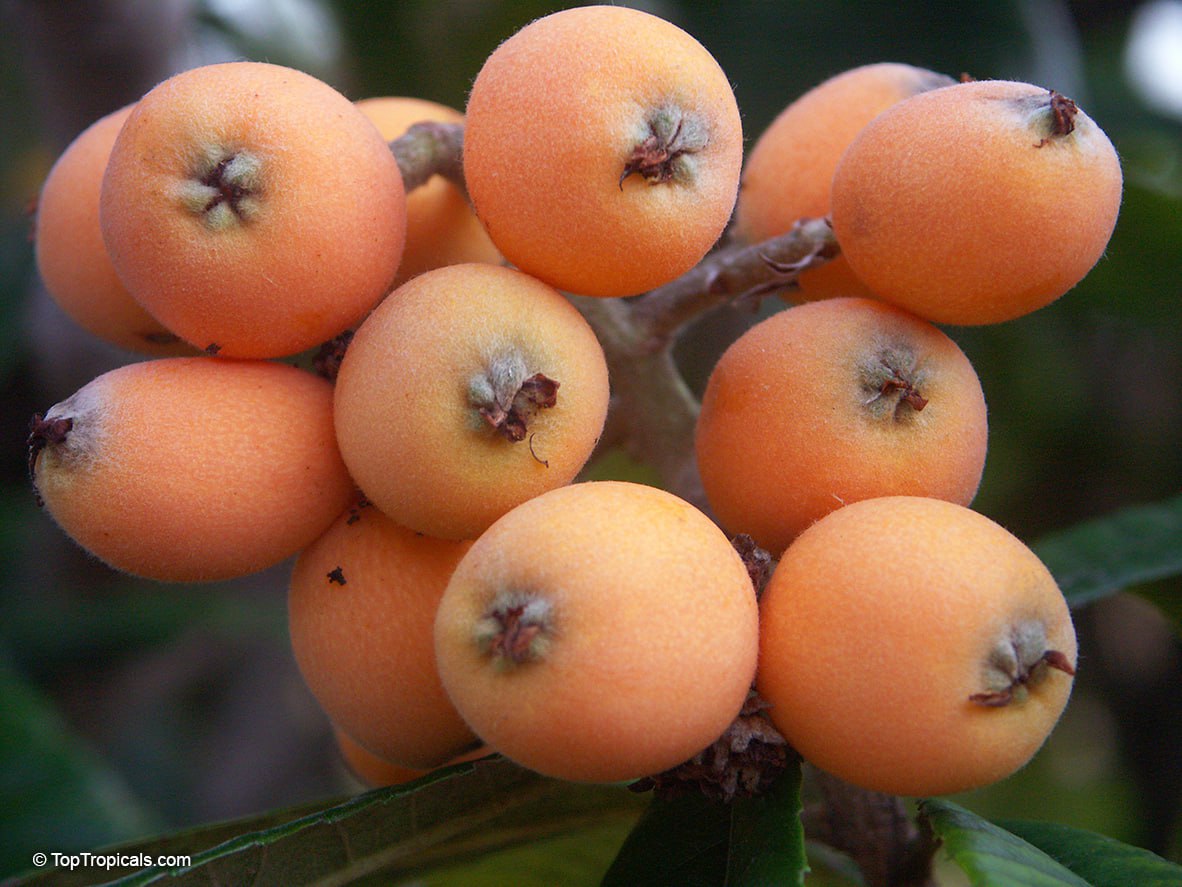
Loquat (Eriobotrya japonica) fruit
- 🍑 Loquat tree (Eriobotrya japonica) is fast-growing, drought-tolerant, cold-tolerant, compact tropical fruit tree.
- 🍑 Heavy producer. Fruits are juicy, aromatic, and resemble apricots. Ripen from early Spring to early Summer.
- 🍑 Ideal for small gardens, beginner fruit tree growers.
- 🍑 High in sugar, acids, vitamins B and C, minerals, and pectin.
- 🍑 Eaten fresh, used in fruit salads, jams, jellies, chutneys, pies, tarts, and wine
- 🍑 Grown in Japan for over 1,000 years. In China, represents gold and wealth, often included in auspicious displays or offerings for prosperity💰
Popular as a natural sweetener and for creating sauces.
📚 Learn more about Loquats
'>🎥 YouTube video about Loquat
📁 Overlooked fruit: tasty Loquat recipes (PDF)
🛒Start your fruit garden with Loquats
#Food_Forest #Recipes
🏵 TopTropicals
What is the best fruit tree producing in winter
Loquat flowers
- 🍑 If you answered the quiz What makes loquats different from other fruits - then you know that Loquat trees flower and produce fruit during the winter months, making them a rare source of fresh fruit when most other trees are dormant.
- 🍑 Loquat flowers are very pretty! Loquats are relatives of Apples, Peaches, Plums and Pears - they belong to Rosaceae family.
🎥 Loquats are in full bloom in our garden now. The fruit will ripen by April
📚 More about Loquat from previous posts:
- 💋Top 10 fruit you'll ever need for your health benefits: #10 Loquat
- 💋Loquat Liquor recipe
- 💋Top 10 fast-fruiting trees:#5. Loquat (Eriobotrya japonica)
- 💋Golden Loquat – the Symbol of Prosperity, and it tastes like apricots
🛒 Plant a Loquat Tree
#Food_Forest #Fun_Facts #Loquat
🔴 Join 👉 TopTropicals
Ten best fruit trees to grow in Florida and Southern landscapes
# 10: Loquat Tree.
- 🍑 Loquat tree (Eriobotrya japonica) is a fast-growing, drought-tolerant, and highly cold-hardy tropical fruit tree.
- 🍑 Heavy Producer: Loquats are juicy, aromatic, and apricot-like in flavor, ripening from early Spring to early Summer.
- 🍑 Compact and Ideal for Small Gardens: Perfect for beginners and those with limited space.
- 🍑 Undemanding: Loquat trees thrive in any soil, tolerate summer heat, winter cold, heavy rains, and occasional flooding.
- 🍑 Nutrient-Rich: High in sugar, acids, vitamins B and C, minerals, and pectin. Eaten fresh or used in fruit salads, jams, jellies, chutneys, sauces, pies, and wine-making. It's also popular as a natural sweetener.
📚 Learn more from previous posts:
- 🟡about #Loquat
- 🟡Loquat – the Symbol of Prosperity
- 🟡Learn more about Loquats
- 🟡10 best fruit trees to grow in Florida and Southern landscapes
🎥 YouTube video about Loquat
📁 Overlooked fruit: tasty Loquat recipes (PDF)
🛒 Start your fruit garden with Loquats
#Food_Forest #Loquat
🔴 Join 👉 TopTropicals
Date:
Discover 10
best fruit trees to grow
in Florida and Southern landscapes
Q: We recently moved into our new home in Florida, and the property is a great size - 5 acres - but it currently has no trees, just a few palms. I'm looking to plant some productive fruit trees to start building our own Food Forest. What fruit trees would you recommend as a good starting point?
A: With five acres of space, you have a fantastic opportunity to create a fruitful garden that can provide for your family for many years to come. Below are our top recommendations for must-have, easy-to-grow fruit trees that thrive in Florida's climate, grow quickly, and start producing right away.
1. Mango Tree
Mango trees (Mangifera indica) are a must-have for any Florida garden, embodying the essence of the Sunshine State with their delicious and nutritious fruit packed with vitamins and fiber. These fast-growing, low-maintenance trees thrive with minimal water and are heat-tolerant. Grafted varieties produce high-quality, fiberless fruit in just 2-3 years, while dwarf "condo" mangoes are perfect for smaller spaces or containers. While young trees need frost protection, mature trees handle cold better. Grafted mangoes offer rich taste that you won't find in commercially grown, fibrous varieties, ensuring a sweet and vibrant harvest from your own garden.
2. Avocado Tree
The Avocado tree (Persea americana) is an essential addition to any tropical or subtropical garden. Known for its health benefits and superfood status, it's a favorite fruit that's not only productive but also a beautiful ornamental tree. Some avocado varieties are more cold-tolerant than mango trees, with the ability to survive temperatures below 25F. While many enjoy growing avocado from seed, only grafted trees guarantee quality fruit and immediate production, as seedlings can take 7-8 years to bear fruit. To successfully grow avocado, ensure good drainage by planting on a raised mound (4-6 inches) and keep the soil consistently moist. There are also compact varieties like Wurtz and Fuerte that thrive in containers or small spaces, making them ideal for patios and small gardens.
3. Tropical Cherries
Tropical cherries, such as Cherry of the Rio Grande (Eugenia aggregata), Grumichama (Eugenia brazilensis), Pitomba (Eugenia luschnathiana), and Black Surinam Cherry (Eugenia uniflora var. Lolita), are popular and easy-to-grow fruit trees that offer fast growth and excellent fruit production. These compact, versatile trees thrive in both the ground and containers, starting to produce fruit almost immediately. Eugenias are low-maintenance, requiring minimal water, thriving in various soil types, and being pest-free. They are heat-tolerant and can endure cool winters, surviving light frosts. Birds love the fruit, but don't worry - there will always be plenty for everyone.
4. Barbados Cherry Tree
Barbados Cherry (Malpighia glabra), also known as Acerola, is a tropical cherry renowned for having the highest vitamin C content of any fruit. This nutrient-packed fruit is perfect for jellies, jams, and freezing without losing its vitamin C. The Barbados Cherry is a fast-growing, dense shrub that fruits multiple times a year, providing abundant harvests for gardeners seeking quick results. It thrives in alkaline soil, tolerates drought, and is relatively cold-hardy, withstanding light freezes. Birds love the fruit, making it a great addition to wildlife-friendly gardens. The dwarf variety, Nana, with its small leaves and fruit, is perfect for containers, borders, or even bonsai, adding ornamental value to any space.
5. Noni Tree
The Noni Tree (Morinda citrifolia) is a top superfood plant that makes a fantastic addition to any Southern garden. Known for its numerous medicinal benefits, Noni fruit offers anti-inflammatory properties, relief from arthritis, and support for conditions like diabetes, metabolism, and weight loss. It's even believed to help fight cancer. Noni trees grow quickly and begin producing fruit within 2 years from seed. This tough, resilient plant thrives in poor soil, endures summer heat, and withstands drought conditions. Despite its tropical appearance, Noni is surprisingly cold-hardy, recovering well after leaf damage in cooler weather. In addition to its health benefits, the Noni tree has ornamental value, with large, waxy leaves and unique fruit, where the flower appears to grow directly on the fruit!
6. Macadamia Nut Tree
The Macadamia Nut Tree (Macadamia integrifolia) is a fantastic addition to any garden, allowing you to grow these delicious, high price tag, nutrient-rich nuts right at home. These trees are cold-hardy, grow quickly, and thrive in all Florida soil types. Once established, they are productive and can tolerate both flooding and drought. Older trees can survive colder winters, while young trees need protection from temperatures below 25-26F. Macadamia trees like plenty of water and a special fertilizer program, including liquid fertilizers and microelements, to ensure healthy root development and optimal production. Aside from being rich in healthy fats, vitamins, and minerals, macadamia nuts offer numerous health benefits, such as improved digestion, heart health, weight management, and blood sugar control. They are also packed with tocotrienols - antioxidants which may protect against cancer and brain diseases.
7. Papaya Tree
Papaya trees (Carica papaya) are resilient, easy to grow, and produce fruit year-round. Rich in papain, a digestive enzyme, papayas are a superfood that promotes gut health. These fast-growing trees often begin producing fruit within the same year they're planted, providing quick rewards for gardeners. Many varieties, especially dwarf papayas, are space-efficient, reaching only 6-8 feet tall while still yielding large crops, making them perfect for small gardens. Surprisingly hardy for a tropical plant, papayas can withstand light freezes and strong winds (tested in hurricanes!). While they are self-fertile, planting 2-3 different cultivars improves pollination and increases yields. "Solo" cultivars, with their smaller, round or oval fruits, are sweet and less susceptible to fruit flies.
8. Guava Tree
Guava trees are beloved for their flavorful fruit, commonly used in juices, drinks, and desserts. Popular varieties include Tropical Guava (Psidium guajava), Cattley Guava (Psidium littorale), Cas Guava (Psidium friedrichsthalianum), and Pineapple Guava (Feijoa sellowiana). Despite their tropical nature, guavas are surprisingly cold-hardy, suitable for cooler climates and occasional frost. These trees thrive in moist conditions and can tolerate some flooding, while their compact growth makes them easy to maintain at any height or shape. Guavas are fast-fruiting, often producing fruit within a year of planting, and even some varieties in 1 gal containers. The dwarf Nana variety is perfect for container culture, producing full-sized fruit in a compact form. Guava trees are mostly pest-resistant, though mealybugs may require occasional treatment with neem oil in humid, rainy areas. Planting multiple guava trees ensures a continuous supply of fresh, juicy fruit and delicious guava juice for everyone to enjoy.
9. Jackfruit Tree
The Jackfruit tree (Artocarpus heterophyllus) is a striking, fast-growing tree known for producing the largest fruit grown on a tree, making it a showstopper in any garden. Nutrient-packed and often used as a meat substitute in South Asian cuisine, Jackfruit is also delicious in curries, chutneys, and as dehydrated chips. These trees grow quickly, have large waxy leaves, and can be maintained at a compact height of 7-8 feet, making them ideal for smaller spaces and easier cold protection. Despite being a tropical species, Jackfruit trees are relatively cold-tolerant and can survive light frost (although on the account of production volume), with established trees being more hardy than seedlings. Jackfruit trees begin producing fruit within 3-4 years from seed, and varieties come true to seed, eliminating the need for grafting, though it can be done for specific varieties.
10. Loquat Tree
The Loquat tree (Eriobotrya japonica) is a fast-growing, drought-tolerant, and highly cold-hardy tropical fruit tree that thrives in Florida gardens. Loquats are heavy producers, with juicy, aromatic fruit that ripens from early spring to early summer, offering a delicious apricot-like flavor. This compact tree is perfect for small gardens, beginners, and those with limited space. Loquats are undemanding, thriving in any soil and withstanding summer heat, winter cold, heavy rains, and occasional flooding. Nutrient-rich, they are high in sugar, acids, vitamins B and C, minerals, and pectin. Loquats are versatile, enjoyed fresh or used in fruit salads, jams, jellies, chutneys, pies, sauces, and even wine-making, and they are often used as a natural sweetener.

